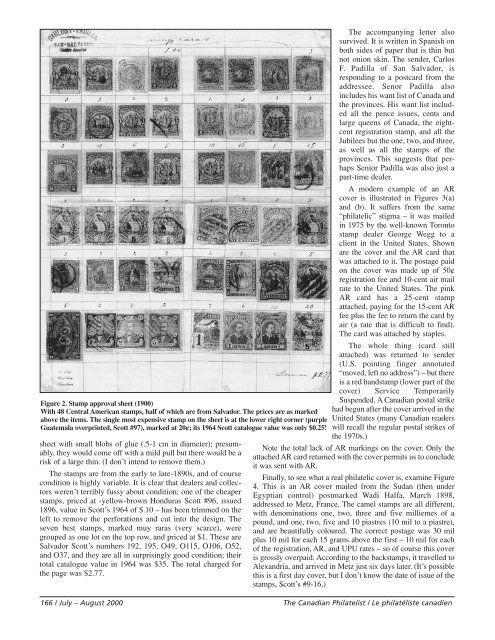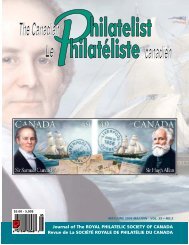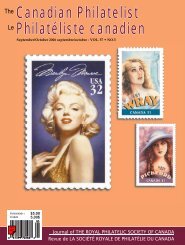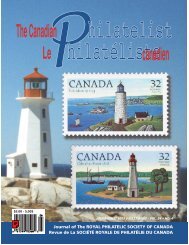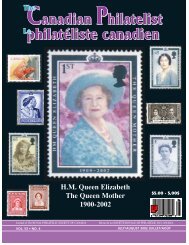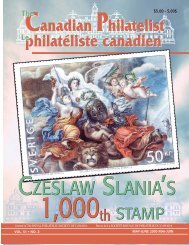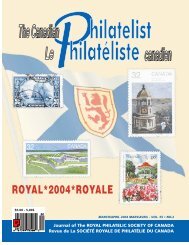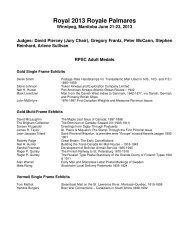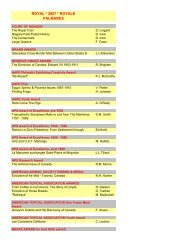Phil pages July-Aug-Final - The Royal Philatelic Society of Canada
Phil pages July-Aug-Final - The Royal Philatelic Society of Canada
Phil pages July-Aug-Final - The Royal Philatelic Society of Canada
Create successful ePaper yourself
Turn your PDF publications into a flip-book with our unique Google optimized e-Paper software.
Figure 2. Stamp approval sheet (1900)<br />
With 48 Central American stamps, half <strong>of</strong> which are from Salvador. <strong>The</strong> prices are as marked<br />
above the items. <strong>The</strong> single most expensive stamp on the sheet is at the lower right corner (purple<br />
Guatemala overprinted, Scott #97), marked at 20¢; its 1964 Scott catalogue value was only $0.25!<br />
sheet with small blobs <strong>of</strong> glue (.5-1 cm in diameter); presumably,<br />
they would come <strong>of</strong>f with a mild pull but there would be a<br />
risk <strong>of</strong> a large thin. (I don’t intend to remove them.)<br />
<strong>The</strong> stamps are from the early to late-1890s, and <strong>of</strong> course<br />
condition is highly variable. It is clear that dealers and collectors<br />
weren’t terribly fussy about condition; one <strong>of</strong> the cheaper<br />
stamps, priced at -yellow-brown Honduras Scott #96, issued<br />
1896, value in Scott’s 1964 <strong>of</strong> $.10 – has been trimmed on the<br />
left to remove the perforations and cut into the design. <strong>The</strong><br />
seven best stamps, marked muy raras (very scarce), were<br />
grouped as one lot on the top row, and priced at $1. <strong>The</strong>se are<br />
Salvador Scott’s numbers 192, 195, O49, O115, O106, O52,<br />
and O37, and they are all in surprisingly good condition; their<br />
total catalogue value in 1964 was $35. <strong>The</strong> total charged for<br />
the page was $2.77.<br />
<strong>The</strong> accompanying letter also<br />
survived. It is written in Spanish on<br />
both sides <strong>of</strong> paper that is thin but<br />
not onion skin. <strong>The</strong> sender, Carlos<br />
F. Padilla <strong>of</strong> San Salvador, is<br />
responding to a postcard from the<br />
addressee. Senor Padilla also<br />
includes his want list <strong>of</strong> <strong>Canada</strong> and<br />
the provinces. His want list included<br />
all the pence issues, cents and<br />
large queens <strong>of</strong> <strong>Canada</strong>, the eightcent<br />
registration stamp, and all the<br />
Jubilees but the one, two, and three,<br />
as well as all the stamps <strong>of</strong> the<br />
provinces. This suggests that perhaps<br />
Senior Padilla was also just a<br />
part-time dealer.<br />
A modern example <strong>of</strong> an AR<br />
cover is illustrated in Figures 3(a)<br />
and (b). It suffers from the same<br />
“philatelic” stigma – it was mailed<br />
in 1975 by the well-known Toronto<br />
stamp dealer George Wegg to a<br />
client in the United States. Shown<br />
are the cover and the AR card that<br />
was attached to it. <strong>The</strong> postage paid<br />
on the cover was made up <strong>of</strong> 50¢<br />
registration fee and 10-cent air mail<br />
rate to the United States. <strong>The</strong> pink<br />
AR card has a 25-cent stamp<br />
attached, paying for the 15-cent AR<br />
fee plus the fee to return the card by<br />
air (a rate that is difficult to find).<br />
<strong>The</strong> card was attached by staples.<br />
<strong>The</strong> whole thing (card still<br />
attached) was returned to sender<br />
(U.S. pointing finger annotated<br />
“moved, left no address”) – but there<br />
is a red handstamp (lower part <strong>of</strong> the<br />
cover) Service Temporarily<br />
Suspended. A Canadian postal strike<br />
had begun after the cover arrived in the<br />
United States (many Canadian readers<br />
will recall the regular postal strikes <strong>of</strong><br />
the 1970s.)<br />
Note the total lack <strong>of</strong> AR markings on the cover. Only the<br />
attached AR card returned with the cover permits us to conclude<br />
it was sent with AR.<br />
<strong>Final</strong>ly, to see what a real philatelic cover is, examine Figure<br />
4. This is an AR cover mailed from the Sudan (then under<br />
Egyptian control) postmarked Wadi Halfa, March 1898,<br />
addressed to Metz, France. <strong>The</strong> camel stamps are all different,<br />
with denominations one, two, three and five milliemes <strong>of</strong> a<br />
pound, and one, two, five and 10 piastres (10 mil to a piastre),<br />
and are beautifully coloured. <strong>The</strong> correct postage was 30 mil<br />
plus 10 mil for each 15 grams above the first – 10 mil for each<br />
<strong>of</strong> the registration, AR, and UPU rates – so <strong>of</strong> course this cover<br />
is grossly overpaid. According to the backstamps, it travelled to<br />
Alexandria, and arrived in Metz just six days later. (It’s possible<br />
this is a first day cover, but I don’t know the date <strong>of</strong> issue <strong>of</strong> the<br />
stamps, Scott’s #9-16.)<br />
166 / <strong>July</strong> – <strong>Aug</strong>ust 2000 <strong>The</strong> Canadian <strong>Phil</strong>atelist / Le philatéliste canadien


